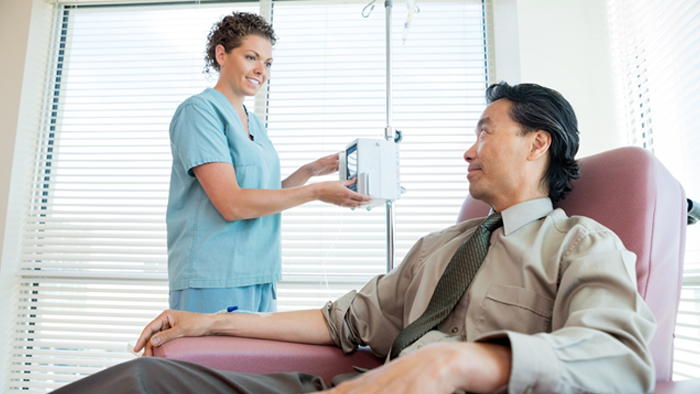IV treatment involves being hooked up to a drip. You will have seen images of it in the movies if you have not experienced it in person. The classic image is of a bag on a tall stick with wheels. The bag is attached by a tube to a needle which is stuck in your skin. IV stands for ‘Intravenous’ which in turns, translates as “within vein’.
The needle is put into your vein to allow the fluid and any medication you need to go directly into your blood stream. IV treatment is very common and usually involves one of your surface veins. It can be an exceptionally effective way of adding antibiotics to your system and ensuring they are focused in a specific area.

A variant of IV treatment involves adding the tube to a much deeper, larger vein; or even the heart itself. This is usually done to encourage faster delivery of the medicine and to prevent it from irritating the heart. If you need repetitive IV treatment then you are likely to have the deep vein type combined with a sheath to provide an easy access into your skin.
It is this type which is often used for more serious conditions and is the type that is commonly administered at home. It is worth noting that self administering with surface veins is fairly simple and can be administered at home.
In fact, some IV treatments, such as those connected with IVF can be completed at home by the patient with very minimal training.
Home IV Treatment
However, the majority of IV treatments at home will need to be arranged by a medical professional and specific instructions will be provided. This is because repetitive IV treatment requires the doctor to insert a needle and sheath into your main vein; or even your heart. This sheath will travel through your vein to the surface of your skin. It will then emerge from the vein and have a valve to prevent blood flowing out of your body. By adopting this approach a nurse or doctor can quickly hook an IV treatment drip up to your sheath and add valuable medicine to your body.
It is possible to have this done at home; there are two options:
- The nurse will visit you when you need your IV treatment. They will check your general health and ensure there is no sign of infection round the opening of your sheath. It is essential to check this often as an infection could travel straight up the tube and into your heart.
They will then administer your IV treatment and wait for it to finish. At this point they will remove the connection and make sure everything is sealed properly before leaving you to it.
This is the usual approach for anyone who has not self-administered before. You may have a quick injection of medicine through this sheath or you may need a slow addition whilst being hooked to a drip.
- The alternative is to be shown how to do the procedure and then complete it yourself. This is perfectly acceptable and safe. However, you will need to take every precaution to ensure you keep the area clean and germ free. You will also need regular checkups to ensure this is the case and that the medicine is having the desired effect.
Administering your IV treatment at home will help you to retain more control of your life in what is sure to be a difficult time.